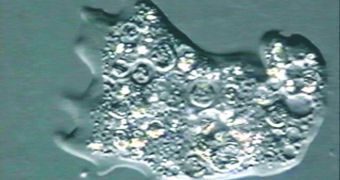Bacteria, microbes, and other single-celled organisms are certainly among the most interesting in the world, especially when considering their amazing resilience when faced with adverse conditions. They have the ability to adapt, evolve, and eventually endure in every type of conceivable environment, where larger organisms have no chance of doing the same. One of the things that allows for them to do that is the fact that they are not picky when it comes to their food. Researchers were even able to demonstrate in a new paper that amoebas given multiple food opportunities would always select the one that brought the most balanced amounts of nutrients, AlphaGalileo reports.
Scientists at the French National Center of Scientific Research (CNRS) drew this conclusion based on their studies of social amoebas, which are single-celled organisms living in extensive colonies. The research group, led by expert Audrey Dussutour, from the CNRS Centre de Recherche sur la Cognition Animale, faced the microorganisms with multiple sources of food at the same time, and observed their behavior. It quickly became visible that the preferred food was the one that brought in all the necessary nutrients, in precisely the correct amounts the organisms needed.
What is so peculiar about these creatures is the fact that they have no organs for decision, or for anything else for that matter. They are a single cell, simple in its design, but that is apparently able to perform highly complex dietary choices without breaking a sweat. Details of this new finding appear in the February 9 issue of the respected journal Proceedings of the National Academy of Sciences (PNAS). The research focused on the simple amoeba organism known as Physarum polycephalum, which has a single cell featuring thousands of nuclei.
In other animals, the nutrient requirements are centralized by the brain, which picks up impulses from individual cells, and eventually dictates what the body needs. The animal then proceeds to search for the type of food that it knows incorporates the necessary nutrients. The amoeba colonies were found to extend further and faster in solutions with a low concentration of nutrients, and also appeared to prefer proteins over sugar. In other experiments, the cells were subjected to food sources that featured proteins and sugars in equal amounts. They were found to spread mostly over the protein part of the food source, so as to keep their intake constant. The researchers are now trying to figure out how they do this.

 14 DAY TRIAL //
14 DAY TRIAL //